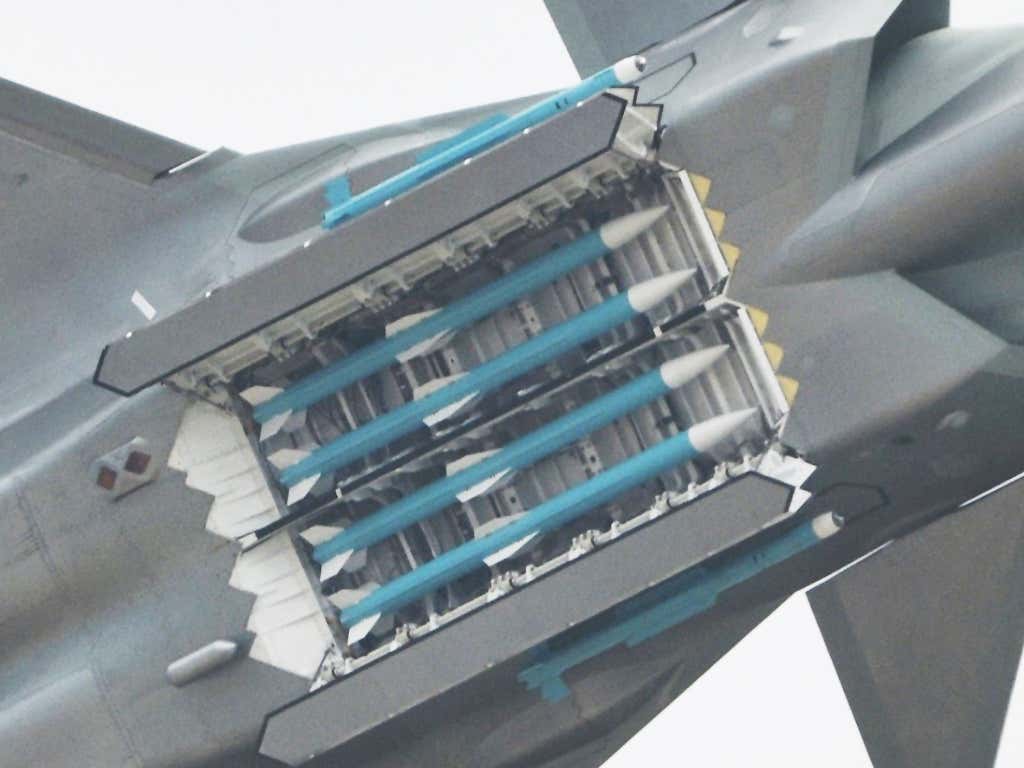This May Be Our First Glimpse of China’s New Air-Launched Anti-Radiation Missile

An image that appeared over the weekend appears to show, for the first time, a new anti-radiation missile, which would primarily be used to destroy hostile radars, intended to arm Chinese combat jets. Two of the missiles are seen under the wings of a People’s Liberation Army Air Force J-11BS Flanker two-seat multirole fighter jet as it takes off.
While there is no information about how this new missile might work or the kind of performance that might be expected, a typical anti-radiation missile (ARM) functions by homing in on radio-frequency emissions from hostile surface-to-air radar systems. Typically, these weapons require high speed in order to ensure they can hit their target before it switches off its radar.
Andreas Rupprecht, a Chinese military aerospace expert and friend of The War Zone who tweets as @RupprechtDeino, was among the first to highlight it and has said he thinks it is China’s new anti-radiation missile, noting that its appearance has been “long expected.” The original source of the image is a brief clip in a recent People’s Liberation Army Air Force (PLAAF) pilot recruitment video that was then posted to Facebook by a user named @柳成梁.
The fact that the tail fins of the J-11BS are obscured means it’s not possible to determine what unit the jet is assigned to, and whether it is from an operational unit, or a test and evaluation outfit. It’s also worth noting that the image also shows, apparently for the first time, a PLAAF J-11BS wearing low-visibility national markings, a trend that now seems to be taking hold among that service’s frontline units.

Close-up of a J-20 fighter carrying four PL-15 air-to-air missiles in its main ventral bays
An example of the possible ARM, which appears to be fairly large, is carried under each of the fighter’s wings. The poor quality of the image doesn’t reveal many details of the missile, although it seems to have prominent cruciform fins on its mid-body section and at the rear, very similar to the U.S. military’s AGM-88 High-Speed Anti-Radiation Missile (HARM)
Other observers were quick to point out the purported ARM’s similarity to another Chinese-developed ARM, the CM-102, although this weapon also seems to have some key differences. Notably, the CM-102’s fins are cropped rather than pointed, and the mid-body fins are long and fairly slender. Apart from this, the CM-102 was also developed by China for export — primary for the JF-17 Thunder multirole fighter — and is not known to be in PLAAF service.
The new weapon also shares some features with the Indian Rudram-1 ARM that was test-launched from an Indian Air Force (IAF) Su-30MKI Flanker two-seat multirole fighter on October 9, 2020. You can read more about this weapon in this previous War Zone story.
Like India, China has relied primarily on Soviet-designed ARMs to equip its aircraft for the suppression of enemy air defences (SEAD) mission. The most important of these weapons is the Kh-31P, known to NATO as the AS-17 Krypton, and its locally produced version, the YJ-91, or Hongdu YingJi-91.
Moscow agreed to provide China with the blueprints required to develop a version of the Kh-31P in 1994. While the missile’s airframe and engine are thought to be similar to the original, China reportedly adapted the seeker to meet local requirements. However, the basic Kh-31 dates back to the late 1970s and it would make sense for China to be working on a more modern, and fully indigenous, successor. Furthermore, the considerable size of the Kh-31/YJ-91 puts it beyond the capacity of the lighter J-10 multirole fighter, which could potentially carry the new weapon in a SEAD role, much like the U.S. Air Force’s own F-16 “Wild Weasel” force.
In particular, a new ARM might be expected to arm the J-16D, a dedicated suppression of enemy air defences (SEAD), and electronic warfare (EW) version of the J-16. This is thought to be equipped with an active electronically scanned array (AESA) radar with specialized EW modes and also sports wingtip electronic pods thought to be analogous to the AN/ALQ-218 used on the EA-18G Growler.
In the past, however, it was anticipated that the new-generation Chinese ARM would either be a version of the CM-102 or an air-to-ground version of the PL-15 air-to-air missile. As a beyond-visual-range weapon, the PL-15 would make a potentially suitable candidate for an ARM derivative, potentially swapping out its air-to-air radar with a passive homing seeker to engage air defence targets and, since the PL-15 is scaled for internal carriage in the stealthy J-20 fighter, an ARM version could equip this jet, too. On the other hand, if the new weapon is indeed an ARM, then it would appear that China has chosen a different development path altogether.
Whatever the case, it seems that ARMs will play an increasingly important role for the PLAAF in the future, especially in light of the developing air defence capabilities among China’s major regional rivals. These include India, whose air defence capabilities include the Russian-supplied S-400 surface-to-air missile, and Taiwan, for which the U.S. government earlier this year approved a possible refresh of its Patriot Advanced Capability-3 (PAC-3) missiles.
In the meantime, we will have to wait for more imagery before we can confirm that this really is China’s new air-launched radar-killing missile, but the alternative explanations are few in number and far less logical.



No comments:
Post a Comment